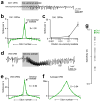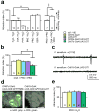Olfactory processing and behavior downstream from highly selective receptor neurons
- PMID: 17417635
- PMCID: PMC2838507
- DOI: 10.1038/nn1881
Olfactory processing and behavior downstream from highly selective receptor neurons
Abstract
In both the vertebrate nose and the insect antenna, most olfactory receptor neurons (ORNs) respond to multiple odors. However, some ORNs respond to just a single odor, or at most to a few highly related odors. It has been hypothesized that narrowly tuned ORNs project to narrowly tuned neurons in the brain, and that these dedicated circuits mediate innate behavioral responses to a particular ligand. Here we have investigated neural activity and behavior downstream from two narrowly tuned ORN types in Drosophila melanogaster. We found that genetically ablating either of these ORN types impairs innate behavioral attraction to their cognate ligand. Neurons in the antennal lobe postsynaptic to one of these ORN types are, like their presynaptic ORNs, narrowly tuned to a pheromone. However, neurons postsynaptic to the second ORN type are broadly tuned. These results demonstrate that some narrowly tuned ORNs project to dedicated central circuits, ensuring a tight connection between stimulus and behavior, whereas others project to central neurons that participate in the ensemble representations of many odors.
Conflict of interest statement
Figures






Similar articles
-
Sensory processing in the Drosophila antennal lobe increases reliability and separability of ensemble odor representations.Nat Neurosci. 2007 Nov;10(11):1474-82. doi: 10.1038/nn1976. Epub 2007 Oct 7. Nat Neurosci. 2007. PMID: 17922008 Free PMC article.
-
Social regulation of aggression by pheromonal activation of Or65a olfactory neurons in Drosophila.Nat Neurosci. 2011 Jun 19;14(7):896-902. doi: 10.1038/nn.2836. Nat Neurosci. 2011. PMID: 21685916
-
Excitatory interactions between olfactory processing channels in the Drosophila antennal lobe.Neuron. 2007 Apr 5;54(1):89-103. doi: 10.1016/j.neuron.2007.03.010. Neuron. 2007. PMID: 17408580 Free PMC article.
-
Working range of stimulus flux transduction determines dendrite size and relative number of pheromone component receptor neurons in moths.Chem Senses. 2012 May;37(4):299-313. doi: 10.1093/chemse/bjr122. Epub 2012 Jan 9. Chem Senses. 2012. PMID: 22230170 Review.
-
Olfactory maps and odor images.Curr Opin Neurobiol. 2002 Aug;12(4):387-92. doi: 10.1016/s0959-4388(02)00348-3. Curr Opin Neurobiol. 2002. PMID: 12139985 Review.
Cited by
-
Fruitless, doublesex and the genetics of social behavior in Drosophila melanogaster.Curr Opin Neurobiol. 2009 Apr;19(2):200-6. doi: 10.1016/j.conb.2009.04.001. Epub 2009 Jun 21. Curr Opin Neurobiol. 2009. PMID: 19541474 Free PMC article. Review.
-
DSL-Notch signaling in the Drosophila brain in response to olfactory stimulation.Neuron. 2011 Feb 10;69(3):468-81. doi: 10.1016/j.neuron.2010.12.015. Neuron. 2011. PMID: 21315258 Free PMC article.
-
Pleiotropic actions of the male pheromone cis-vaccenyl acetate in Drosophila melanogaster.J Comp Physiol A Neuroethol Sens Neural Behav Physiol. 2015 Sep;201(9):927-32. doi: 10.1007/s00359-015-1020-9. Epub 2015 Jun 24. J Comp Physiol A Neuroethol Sens Neural Behav Physiol. 2015. PMID: 26105507 Free PMC article. Review.
-
Dynamics of Glutamatergic Drive Underlie Diverse Responses of Olfactory Bulb Outputs In Vivo.eNeuro. 2021 Apr 19;8(2):ENEURO.0110-21.2021. doi: 10.1523/ENEURO.0110-21.2021. Print 2021 Mar-Apr. eNeuro. 2021. PMID: 33795414 Free PMC article.
-
Feeding regulates sex pheromone attraction and courtship in Drosophila females.Sci Rep. 2015 Aug 10;5:13132. doi: 10.1038/srep13132. Sci Rep. 2015. PMID: 26255707 Free PMC article.
References
-
- Duchamp-Viret P, Chaput MA, Duchamp A. Odor response properties of rat olfactory receptor neurons. Science. 1999;284:2171–4. - PubMed
-
- Malnic B, Hirono J, Sato T, Buck LB. Combinatorial receptor codes for odors. Cell. 1999;96:713–23. - PubMed
-
- de Bruyne M, Foster K, Carlson JR. Odor coding in the Drosophila antenna. Neuron. 2001;30:537–52. - PubMed
-
- Hildebrand JG, Shepherd GM. Mechanisms of olfactory discrimination: converging evidence for common principles across phyla. Annu Rev Neurosci. 1997;20:595–631. - PubMed
-
- Wilson RI, Mainen ZF. Early events in olfactory processing. Annu Rev Neurosci. 2006;29:163–201. - PubMed
Publication types
MeSH terms
Substances
Grants and funding
LinkOut - more resources
Full Text Sources
Molecular Biology Databases

